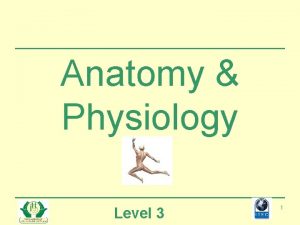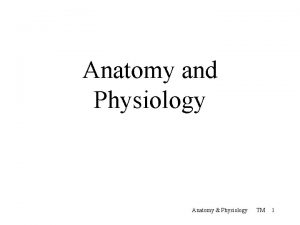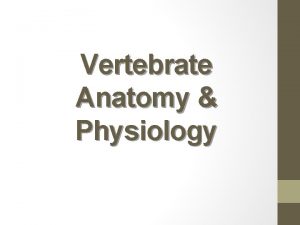SAP 1 LANGUAGE OF ANATOMY AND PHYSIOLOGY Standard
































- Slides: 32

SAP 1 LANGUAGE OF ANATOMY AND PHYSIOLOGY ● Standard anatomical body position ● Directional terms ● Body planes ● Body cavities ● Regional terms Copyright © 2010 Pearson Education, Inc.

ANATOMICAL POSITION ● Standard anatomical body position: ● Body erect ● Feet slightly apart ● Palms facing forward ● Supine – lying face upward ● Prone – lying face downward Copyright © 2010 Pearson Education, Inc.

Directional Terms Superior Inferior Anterior Posterior Superficial Deep Proximal Distal Medial Lateral (Anatomical Position) Copyright © 2010 Pearson Education, Inc.

Copyright © 2010 Pearson Education, Inc. Table 1. 1

Copyright © 2010 Pearson Education, Inc. Table 1. 1

Copyright © 2010 Pearson Education, Inc. Table 1. 1

Copyright © 2010 Pearson Education, Inc. Table 1. 1

Copyright © 2010 Pearson Education, Inc. Table 1. 1

BODY PLANES Plane: Flat surface along which body or structure is cut for anatomical study Copyright © 2010 Pearson Education, Inc.

BODY PLANES ● Sagittal plane Divides a structure vertically into right and left parts Produces a sagittal section ● Midsagittal (median) plane Divides the body into right and left halves Lies on midline Copyright © 2010 Pearson Education, Inc.

BODY PLANES ● Frontal (coronal) plane Divides body vertically into anterior and posterior parts ● Transverse (horizontal) plane Divides body horizontally into superior and inferior parts Produces a cross section Copyright © 2010 Pearson Education, Inc.

Frontal plane Median (midsagittal) plane Transverse plane (a) Frontal section (through torso) (b) Transverse section (through torso, inferior view) Pancreas (c) Median section (midsagittal) Aorta Spleen Left and Liver Heart Spleen right lungs Stomach Arm Copyright © 2010 Pearson Education, Inc. Liver Spinal cord Body wall Subcutaneous fat layer Intestines Rectum Vertebral column Figure 1. 8

ANATOMICAL VARIABILITY Over 90% of all anatomical structures match textbook descriptions, but: ● Nerves or blood vessels may be somewhat out of place Small muscles may be missing Copyright © 2010 Pearson Education, Inc.

BODY CAVITIES ● Dorsal cavity Protects nervous system ● Two subdivisions: Cranial cavity Encases brain Spinal cavity Encases spinal cord Copyright © 2010 Pearson Education, Inc.

BODY CAVITIES ● Ventral cavity Houses internal organs (viscera) Two subdivisions (separated by diaphragm): Thoracic cavity Abdominopelvic cavity Copyright © 2010 Pearson Education, Inc.

Cranial cavity (contains brain) Dorsal body cavity Ventral body cavity Vertebral cavity Superior mediastinum Pleural cavity Pericardial cavity within the mediastinum Diaphragm Thoracic cavity (contains heart and lungs) Vertebral cavity (contains spinal cord) (a) Lateral view Copyright © 2010 Pearson Education, Inc. Ventral body cavity (thoracic and Abdomino- abdominopelvic cavities) cavity Abdominal cavity (contains digestive viscera) Pelvic cavity (contains urinary bladder, reproductive organs, and rectum) (b) Anterior view Figure 1. 9 a-b

VENTRAL BODY CAVITIES ● Thoracic cavity subdivisions: Two pleural cavities Each houses a lung ● Mediastinum Contains pericardial cavity Surrounds thoracic organs ● Pericardial cavity Encloses heart Copyright © 2010 Pearson Education, Inc.

VENTRAL BODY CAVITIES ● Abdominopelvic cavity subdivisions: Abdominal cavity Contains stomach, intestines, spleen, and liver Pelvic cavity Contains urinary bladder, reproductive organs, and rectum Copyright © 2010 Pearson Education, Inc.

Cranial cavity (contains brain) Dorsal body cavity Ventral body cavity Vertebral cavity Superior mediastinum Pleural cavity Pericardial cavity within the mediastinum Diaphragm Thoracic cavity (contains heart and lungs) Vertebral cavity (contains spinal cord) (a) Lateral view Copyright © 2010 Pearson Education, Inc. Ventral body cavity (thoracic and Abdomino- abdominopelvic cavities) cavity Abdominal cavity (contains digestive viscera) Pelvic cavity (contains urinary bladder, reproductive organs, and rectum) (b) Anterior view Figure 1. 9 a-b

SEROUS MEMBRANE (SEROSA) Thin, double-layered membrane separated by serous fluid ● Allows organs to slide easily across cavity walls and one another without friction Extremely important when mobile organs such as pumping heart and churning stomach are involved ● Parietal serosa lines internal body walls ● Visceral serosa covers the internal organs Copyright © 2010 Pearson Education, Inc.

SEROUS MEMBRANES Specific names of serous membranes depend on their locations: ● PERICARDIUM is serosa lining around the heart ● PLEURA is serosa lining the lungs PERITONEUM is serosa lining abdominal cavities and covering its organs 1. mesenteries are double layers of peritoneum that anchor organs to the body wall 2. Organs, like the kidneys, covered by only one layer of peritoneum are called retroperitoneal ● Copyright © 2010 Pearson Education, Inc.

Outer balloon wall (comparable to parietal serosa) Air (comparable to serous cavity) Inner balloon wall (comparable to visceral serosa) Heart Parietal pericardium Pericardial space with serous fluid Visceral pericardium (b) The serosae associated with the heart. Copyright © 2010 Pearson Education, Inc. Figure 1. 10 a-b

ABDOMINOPELVIC REGIONS ● Nine divisions used primarily by anatomists Copyright © 2010 Pearson Education, Inc.

Right hypochondriac region Epigastric region Left hypochondriac region Right lumbar region Umbilical region Left lumbar region Right iliac (inguinal) region Hypogastric (pubic) region Left iliac (inguinal) region (a) Nine regions delineated by four planes Copyright © 2010 Pearson Education, Inc. Liver Gallbladder Ascending colon of large intestine Small intestine Cecum Appendix Diaphragm Stomach Transverse colon of large intestine Descending colon of large intestine Initial part of sigmoid colon Urinary bladder (b) Anterior view of the nine regions showing the superficial organs Figure 1. 12

ABDOMINOPELVIC QUADRANTS ● Divisions used primarily by medical personnel Copyright © 2010 Pearson Education, Inc.

Right upper quadrant (RUQ) Left upper quadrant (LUQ) Right lower quadrant (RLQ) Left lower quadrant (LLQ) Copyright © 2010 Pearson Education, Inc. Figure 1. 11

OTHER BODY CAVITIES ● Oral and digestive cavities ● Nasal cavity ● Orbital cavities ● Middle ear cavities ● Synovial cavities Copyright © 2010 Pearson Education, Inc.

REGIONAL TERMS ● Two major divisions of body: Axial Head, neck, and trunk Appendicular Limbs Regional terms designate specific areas: Copyright © 2010 Pearson Education, Inc.

Upper limb Acromial Brachial (arm) Antecubital Antebrachial (forearm) Carpal (wrist) Manus (hand) Palmar Pollex Digital Cephalic Frontal Orbital Nasal Oral Mental Cervical Thoracic Axillary Mammary Sternal Abdominal Umbilical Pelvic Inguinal (groin) Pubic (genital) Thorax Abdomen Back (Dorsum) (a) Anterior/Ventral Copyright © 2010 Pearson Education, Inc. Lower limb Coxal (hip) Femoral (thigh) Patellar Crural (leg) Fibular or peroneal Pedal (foot) Tarsal (ankle) Metatarsal Digital Hallux Figure 1. 7 a

Upper limb Acromial Brachial (arm) Olecranal Antebrachial (forearm) Manus (hand) Metacarpal Digital Lower limb Femoral (thigh) Popliteal Sural (calf) Fibular or peroneal Pedal (foot) Calcaneal Plantar Cephalic Occipital (back of head) Otic Cervical Back (dorsal) Scapular Vertebral Lumbar Sacral Gluteal Perineal (between anus and external genitalia) Thorax Abdomen Back (Dorsum) (b) Posterior/Dorsal Copyright © 2010 Pearson Education, Inc. Figure 1. 7 b

Copyright © 2010 Pearson Education, Inc.

Copyright © 2010 Pearson Education, Inc.
 Language
Language Laynx
Laynx Tattoo anatomy and physiology
Tattoo anatomy and physiology Science olympiad anatomy and physiology
Science olympiad anatomy and physiology Crown plants examples
Crown plants examples Anatomy and physiology bones
Anatomy and physiology bones Peptic ulcer anatomy and physiology
Peptic ulcer anatomy and physiology Liver hilus
Liver hilus Difference between anatomy and physiology
Difference between anatomy and physiology Wpigastric region
Wpigastric region Google com
Google com Chapter 14 anatomy and physiology
Chapter 14 anatomy and physiology 3 layers of muscle
3 layers of muscle Http://anatomy and physiology
Http://anatomy and physiology Waistline
Waistline Anatomy and physiology of appendix
Anatomy and physiology of appendix Aohs foundations of anatomy and physiology 1
Aohs foundations of anatomy and physiology 1 Aohs foundations of anatomy and physiology 2
Aohs foundations of anatomy and physiology 2 Anatomical planes
Anatomical planes Anatomy and physiology chapter 8 special senses
Anatomy and physiology chapter 8 special senses Chapter 13 anatomy and physiology of pregnancy
Chapter 13 anatomy and physiology of pregnancy Unit 26 agriscience
Unit 26 agriscience Science olympiad forensics cheat sheet
Science olympiad forensics cheat sheet Anatomy and physiology chapter 2
Anatomy and physiology chapter 2 Stomach anatomy and physiology ppt
Stomach anatomy and physiology ppt Anatomy and physiology diabetes
Anatomy and physiology diabetes Anatomy and physiology chapter 7
Anatomy and physiology chapter 7 Chapter 14 the digestive system and body metabolism
Chapter 14 the digestive system and body metabolism Chapter 10 blood anatomy and physiology
Chapter 10 blood anatomy and physiology Aohs foundations of anatomy and physiology 1
Aohs foundations of anatomy and physiology 1 Aohs foundations of anatomy and physiology 1
Aohs foundations of anatomy and physiology 1 Anatomy and physiology
Anatomy and physiology Anatomy and physiology chapter 15
Anatomy and physiology chapter 15
























































